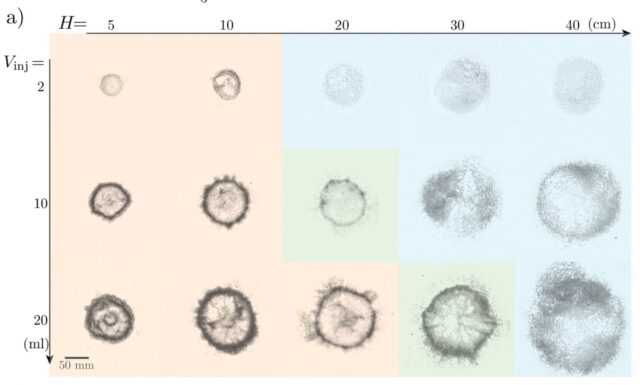
Deposit morphologies for a settling particle. When increasing either the injection volume or the settling height, the deposit radius increases.
Credit:
M. Souzy et al., 2025
They used spherical borosilicate glass beads of varying diameters to represent the grains of salt and loaded different fixed volumes of beads into cylindrical tubes. Then they slid open the tube’s bottom to release the beads, capturing how they fell and settled with a Nikon D300 camera placed at the top of the tank. The tank was illuminated from below by a uniform LED light screen and diffuser to get an even background.
The physicists found that gravity will pull a single particle to the bottom of the tank, creating a small wake drag that affects the flow of water around it. That perturbation becomes much more complicated when many large particles are released at once, each with its own wake that affects its neighbors. So, the falling particles start to shift horizontally, distributing the falling particles in an expanding circular pattern.
Particles released from a smaller height fall faster and form a pattern with a clean central region. Those released from a greater height take longer to fall to the bottom, and the cloud of particles expands radially until the particles are far enough apart not to be influenced by the wakes of neighboring particles such that they no longer form a cloud. In that case, you end up with a homogeneous salt ring deposit.
“These are the main physical ingredients, and despite its apparent simplicity, this phenomenon encompasses a wide range of physical concepts such as sedimentation, non-creeping flow, long-range interactions between multiple bodies, and wake entrainment,” said Souzy. “Things get even more interesting once you realize larger particles are more radially shifted than small ones, which means you can sort particles by size just by dropping them into a water tank. It was a great overall experience, because we soon realized our simple observation of daily life conceals a rich variety of physical mechanisms.”
Those phenomena are just as relevant outside the kitchen, according to the authors, most notably in such geophysical and industrial contexts as “the discharge of dredged materials and industrial waste into rivers lakes and oceans,” they wrote. “In scenarios involving contaminated waste, comprehending the behavior of both the solid waste and the interacting fluid is crucial.”
Physics of Fluids, 2025. DOI: 10.1063/5.0239386 (About DOIs).

